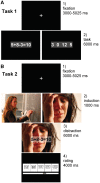Goal-directed behavior under emotional distraction is preserved by enhanced task-specific activation
- PMID: 22302842
- PMCID: PMC3594722
- DOI: 10.1093/scan/nsr098
Goal-directed behavior under emotional distraction is preserved by enhanced task-specific activation
Abstract
Despite the distracting effects of emotional stimuli on concurrent task performance, humans are able to uphold goal-directed behavior. Here, we investigated the hypothesis that this effect is due to the enhanced recruitment of task-specific neural resources. In a two-step functional magnetic resonance imaging study, we first localized those areas involved in mental arithmetics by contrasting arithmetic problems with a number detection task. The resulting activation maps were then used as masks in a second experiment that compared the effects of neutral and emotional distracter images on mental arithmetics. We found increased response times in the emotional distracter condition, accompanied by enhanced activation in task-specific areas, including superior parietal cortex, dorsolateral and dorsomedial prefrontal cortex. This activation increase correlated with larger behavioral impairment through emotional distraction. Similar error rates in both conditions indicate that cognitive task performance is preserved through enhanced recruitment of task-specific neural resources when emotional distracter stimuli are present.
Figures


References
-
- Bradley MM, Lang PJ. Measuring emotion: the self-assessment manikin and the semantic differential. Journal of Behavioral Therary and Experimental Psychiatry. 1994;25:49–59. - PubMed
-
- Dehaene S, Molko N, Cohen L, Wilson AJ. Arithmetic and the brain. Current Opinion in Neurobiology. 2004;14:218–24. - PubMed

